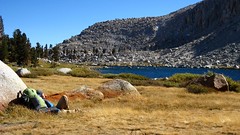
Last fall, my good friends and I went on a week long backpacking trip in the Sierras. We had a great time. But the sight of my dear friend Christina skipping down the trail with her Golite pack carrying around 20 pounds of weight (only that heavy as she got assigned the bear canister) inspired envy in the rest of us who trudged along with our 30+pound packs. (That's how she got stuck with the canister). Inspirational enough for me to really start planning a gear overhaul. Fortunately for me on that trip, I had already made the switch to an ultralight tent.
My issue with ultralight camping has always been the tarp. Apparently, I am a natural homing beacon for mosquitoes and other blood sucking insects. And I am not about to slather myself in a chemical as nasty as DEET every night. While I realize that not every trip involves heavy insect infestations, it only takes one mosquito for one very restless night. So how to tent ultralight? I trolled the backpacker.com forums and found a strong following for Henry Shires Tarptent
I opted for the Rainshadow 2. It's big - sleeps 3 - and weighs 42 oz. That's less than 3 pounds! I wanted a larger tent as I usually backpack with friends, and needed a tent that could fit my boyfriend and my dog. Entirely enclosed yet also ultralight, it is a great option for the bug-phobic like me. After getting it in September, I've used my tarptent for multiday trip in the Sierras, at Joshua Tree in October, and a overnight trip in the Angeles National Forest. Overnight temps have ranged from 50s to the 20s, with windy days and calm days.
My biggest problem with the Rainshadow 2 has been the setup. I'm a pro with freestanding tents (it doesn't take much), but a complete novice pitching a tarp. It requires a really taut setup, especially on those windy or rainy nights. Otherwise you'll be cursed with the loud sound of constant flapping, or pooling puddles of rain in the wrong places. If the ground is hard and rocky (like the campground at JTree) and you have to resort to using rocks to guy out the lines rather than stakes.... UGH! This isn't an issue with the Rainshadow per say, more of a learning curve involved with tarps in general.
PROS:
Lightweight (duh)
Roomy - enough space for 3 as well as enough vestibule space for boots
Enclosed - mesh doors and sidewalls
Bathtub floor - great for those rainy days
CONS:
Setup- Actually the issue with setup is an issue for most tarps - it takes some practice and skill to get a really taut setup, and can be difficult in very hard/rocky ground
Durability - it just doesn't seem as bomber as my old Marmot traditional tent/fly combo.
Big Footprint - the flip side of roomy
Overall, I really like this tent for backpacking. I wouldn't go through the hassle of setup though if I'm car camping as weight isn't an issue. On those nights, I use my trusty Marmot Equinox. I would however, choose a smaller tent like the Rainbow (which is freestanding!) or the Contrail (only 24 oz and entirely enclosed) if I had to do it again. The footprint of the Rainshadow 2 can be challenging to accomodate at times, depending on the site.


No comments:
Post a Comment